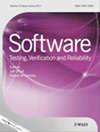属性生成/验证和实证研究
IF 1.2
4区 计算机科学
Q3 COMPUTER SCIENCE, SOFTWARE ENGINEERING
引用次数: 0
摘要
这期有四篇论文。第一篇和第三篇论文分别关注属性生成和属性验证,第二篇和第四篇论文分别关注故障预测算法和测试片度的实证研究。第一篇论文,“基于文档的库方法功能约束生成”,由蒋仁和、陈正昭、裴宇、潘敏学、张田和李宣东撰写,提出了DOC2SMT,一种基于文档为库方法生成功能约束的方法。DOC2SMT首先将方法的文档转换为候选约束子句,然后根据静态和动态验证对其进行过滤。实验结果显示了DOC2SMT的有效性和效率,也显示了生成的约束对于基于符号执行的测试生成(由Peter m本文章由计算机程序翻译,如有差异,请以英文原文为准。
Property generation/verification and empirical studies
This issue contains four papers. The first and third papers focus on property generation and property verification, respectively, while the second and fourth papers focus on empirical studies of a fault prediction algorithm and test flakiness, respectively. The first paper, “Documentation-based functional constraint generation for library methods,” by Renhe Jiang, Zhengzhao Chen, Yu Pei, Minxue Pan, Tian Zhang, and Xuandong Li, proposes DOC2SMT, an approach that generates functional constraints for library methods based on their documentations. DOC2SMT first translates a method’s documentation into candidate constraint clauses, which are then filtered based on static and dynamic validations. The experimental results show the effectiveness and efficiency of DOC2SMT and also show the benefits of the generated constraints for symbolic-execution-based test generation (recommended by Peter Müller). The second paper, “An empirical study of Linespots: A novel past-fault algorithm,” by Maximilian Scholz and Richard Torkar, proposes a new fault prediction algorithm called Linespots. The authors focus on fault prediction based on past faults and refine a previous algorithm (Bugspots). Interestingly, they used a different granularity: line as opposed to file, and this necessitated the development of a benchmark set of experimental subjects. In experiments, Linespots was found to outperform Bugspots (recommended by Xiaoyin Wang). The third paper, “Integrating pattern matching and abstract interpretation for verifying cautions of microcontrollers,” by Thuy Nguyen, Takashi Tomita, Junpei Endo, and Toshiaki Aoki, proposes a semi-automatic approach for verifying cautions, which are hardware-dependent properties described in microcontrollers hardware manuals. For this approach, the authors integrate pattern matching and abstract interpretation, two static program analysis techniques. The experimental results show the feasibility and applicability of the approach (recommended by Marcio Delamaro). The fourth paper, “Empirical analysis of practitioners’ perceptions of test flakiness factors,” by Azeem Ahmad, Ola Leifler, and Kristian Sandahl, concerns flaky tests. A flaky test is one where different executions with the same test can lead to different outcomes/verdicts. The authors explore developer perception regarding factors that affect flakiness, concentrating on developers of closed-source software. They also examine two test suites and identify the test smells that lead to flakiness (recommended by Mike Papadakis).
求助全文
通过发布文献求助,成功后即可免费获取论文全文。
去求助
来源期刊

Software Testing Verification & Reliability
工程技术-计算机:软件工程
CiteScore
3.70
自引率
0.00%
发文量
34
审稿时长
>12 weeks
期刊介绍:
The journal is the premier outlet for research results on the subjects of testing, verification and reliability. Readers will find useful research on issues pertaining to building better software and evaluating it.
The journal is unique in its emphasis on theoretical foundations and applications to real-world software development. The balance of theory, empirical work, and practical applications provide readers with better techniques for testing, verifying and improving the reliability of software.
The journal targets researchers, practitioners, educators and students that have a vested interest in results generated by high-quality testing, verification and reliability modeling and evaluation of software. Topics of special interest include, but are not limited to:
-New criteria for software testing and verification
-Application of existing software testing and verification techniques to new types of software, including web applications, web services, embedded software, aspect-oriented software, and software architectures
-Model based testing
-Formal verification techniques such as model-checking
-Comparison of testing and verification techniques
-Measurement of and metrics for testing, verification and reliability
-Industrial experience with cutting edge techniques
-Descriptions and evaluations of commercial and open-source software testing tools
-Reliability modeling, measurement and application
-Testing and verification of software security
-Automated test data generation
-Process issues and methods
-Non-functional testing
 求助内容:
求助内容: 应助结果提醒方式:
应助结果提醒方式:


